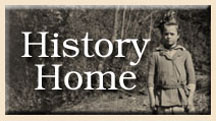

Education
Because Southern Appalachian communities in the late nineteenth to early
twentieth centuries tended to be materially poor, sparsely settled, and largely
devoid of significant industry and commercial agriculture, county school boards
in the region were seldom able to collect tax revenues sufficient to fund
high-quality public schools. Private schools founded by Christian benevolent
societies and other charitable organizations did their best to make up the
difference, but were too few in number, too limited in terms of resources,
and often too far distant from the majority of potential students’ homes
to have a significant impact on local educational standards. And so, most
Southern Appalachian families were relegated to sending their children to
one of the region’s diminutive, one-room public schoolhouses--if, in
fact, they sent them to school at all
.
As a general rule, these one-room, Southern Appalachian schoolhouses were
poorly suited to the task of education. To begin with, the men and women who
staffed them were scarcely better educated than the students they purported
to teach. Few had received more than a fifth-grade education, much less professional
training at a normal school (teachers’ college) or university. To make
matters worse, teaching positions were among the only jobs available to mountaineers
that paid cash, and so were highly coveted. It was not uncommon for elite
families--here meaning those most likely to sit on the local school board--to
reserve such positions for friends and family members, regardless of whether
the potential appointees were qualified to teach.
Still, even a well-trained teacher would have had a difficult time accomplishing
much of significance in a one-room Southern Appalachian school house. Like
the majority of private homes in the region, mountain school houses were most
often constructed of massive, rough-hewn timbers, chinked with wooden slats
and mud. They were, as a result, drafty and windowless, and were often heated
by a single pot-bellied stove that stood near the center of the room. Over
the years, many a mountaineer recalled the physical discomfort of attending
school on blustery winter days; those unfortunate enough to occupy a bench
near the stove spent the day languishing in the stifling heat, while those
who sat near the porous walls spent the day shivering against the biting cold.
As if this were not bad enough, children of all ages and grade levels were
forced by a lack of space to crowd into the same classroom, thereby limiting
the teacher’s ability to spend time with individual students or engage
in specialized subjects. Given these circumstances, and taking into account
the fact that there was seldom enough county money on hand to keep schools
open for more than three or four months in a given school year, it should
come as no surprise that the curriculum was limited to a few basic topics--primarily
reading, writing, spelling, history, and mathematics--with little or no emphasis
placed on the sciences, vocational training, or the fine arts.
It is also worth noting that students were seldom in any condition, physically
speaking, to engage in intensive learning. Unlike communities situated in
more level regions of the country, which were, more often than not, arranged
in an orderly grid pattern, Southern Appalachian communities tended to stretch
up creeks and rivers in long straight lines. Families at the far end of these
lines might be as much as five or ten miles distant from the nearest sizable
settlement--and hence, five or ten miles distant from the nearest schoolhouse.
Because there were no cars or busses in those days, and because it was all
but impossible to transport wagon-loads of children over the narrow, rock-infested
roads, most schoolchildren were relegated to undertaking long, exhausting
walks if they wished to attend school. Add to this the fact that mountain
parents were not in the habit of packing hearty lunches for their children
(or so insisted Pi Beta Phi Settlement School nurse Phyllis Higinbotham),
and it becomes clear why mountain students were notorious for their poor behavior
and lack of interest in intellectual pursuits: most were simply too tired
and too hungry to concentrate on schoolwork.
Sadly, in lieu of county officials obtaining outside assistance, elevating
the region’s educational standards was largely out of the question.
For in addition to the aforementioned problems associated with generating
tax revenues, the mountaineers’ fierce devotion to independent community
schoolhouses (which were numerous, and by their very existence hindered the
formation of consolidated school districts) meant that the meager county tax
revenues that were raised were often spread too thin to be of much practical
use. Not surprisingly, urban-born Progressive Era philanthropists who traveled
to the region in the early nineteenth century, and who were accustomed to
the notion of broad, community-based action as a means to cure social ills,
were baffled by the mountaineers’ intransigence on this issue. As Pi
Beta Phi Settlement School teacher and Tacoma, Washington native Ruth Sturley
put it in October 1919, “It makes one wonder why our school so wonderfully
equipped in comparison [to local schools] is not full to overflowing--that
our enrollment is not two hundred rather than half that number.”
Before we conclude this essay, it also bears mentioning that education took
a back seat to agricultural labor in many a Southern Appalachian household,
regardless of whether or not the family believed in the value of learning.
Such, it seems, is the nature of the subsistence economy; survival comes before
intellectual pursuits, and everyone in the family, including young children,
is liable for ensuring that survival. It should thus come as no surprise that
parents in the more isolated corners of the region permitted them to go to
school only during the winter months—or held them out altogether--thereby
denying them what little education was available at the local schoolhouse.
Education, you might say, was caught in a vicious cycle--one that could only
be broken with the help of benevolent outsiders.
 |
|